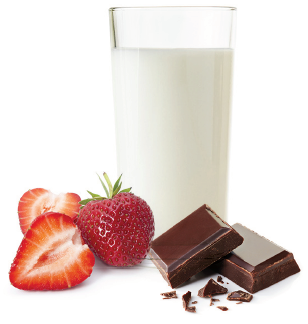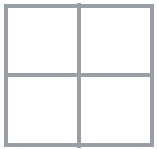This problem solving activity has a logic and reasoning focus.

In how many ways can she fill it with cartons of strawberry and chocolate milk?
- Rotate patterns through quarter and half turns.
- Count possibilities.
The Level 1 Strawberry Milk problem precedes, and lays the foundation for, this lesson. The two main ideas introduced there, and reinforced here, are counting all possible arrangements, and noticing that some of these arrangements are ‘alike' and so might be considered to be the same.
The first part of this problem has students following these steps:
- find some answers to a problem;
- think about whether there are any more answers or not;
- try to explain why there are no more answers.
The students should be encouraged to try to find a number of answers and to reach a point where they have some systematic idea as to why there are no more answers. There are three important skills that are fundamental to all of mathematics; being able to find some possibilities, finding all possibilities and then justifying that there are no more. We work through this sequence in the solution.
The second idea in this problem is symmetry. This involves noticing that turning some arrangements of the milk cartons through quarter turns, will give another arrangement. The two arrangements are said to be ‘alike'. The aim is to find such arrangements, put them into groups and find how many such groups there are. This will confirm the number of different arrangements, or the number of groups that are not ‘alike'.
The problem includes probability elements of Statistics and the rotational symmetry aspect of Geometry.
This problem is one of a series of 8 logic and reasoning problems that builds up to some quite complicated maths based around the theme of no-three-in-a-line. The other lessons are Strawberry Milk, Level 1; Three-In-A-Line, Level 2; No Three-In-A-Line, Level 3; More No-Three-In-A-Line, Level 4; No-Three-In-A-Line Again, Level 5; No-More-In-A-Line Level 6; and No-Three-In-A-Line Game, Level 6.
- Copymaster of the problem (Māori)
- Copymaster of the problem (English)
- Coloured pens and paper
- Square box or region (to use as a crate)
- Copymaster of 2 by 2 crates
- Copymaster of 3 by 3 crates
The Problem
Hannah has a square milk crate that would hold four cartons. In how many ways can she fill it with cartons of strawberry and chocolate milk?
.gif)
- Talk about milk cartons.
- Discuss Hannah's crate (carton holder) using the square box or region.
Why might she have a small crate?
What shape is the crate? What do we know about that shape?
How many cartons can she get into her crate? - Discuss the problem and how the students might approach it, including how they will record their ideas.
- Have the students work on the problem and support them with questions.
- As different solutions emerge, have students take turns to show the class an arrangement they have found. Give a student's name to each solution.
- Have them display their solutions so that the class can refer to them. These can be added to if another one is discovered.
- Ask
How do you know if there are any more?
Can two arrangements actually be the same? - Talk about symmetry and rotating the square so that one arrangement goes to another. Have students decide when two things are ‘alike' or the ‘same'.
- Students who are able to justify their answer could try the Extension.
- As students report back to the class, highlight different approaches to the problem.
Extension
Suppose that Hannah has a 3 by 3 crate. In how many ways can she fill the crate with two cartons of strawberry milk and seven cartons of chocolate milk?
Solution
Students may approach this unsystematically at first. This is what you could expect at step (i) of the process of finding all answers. So they will probably find several ways of putting the cartons into the crate but not be sure that two of them could be considered to be the same and not be able to see why there are no more.
What crate arrangements are ‘alike'? (see Strawberry Milk, Level 1). We can think of the two filled square crates below as being alike because it is possible to rotate one around through a quarter turn, until it looks exactly the same as the other.
![]()
This should provoke a discussion. Are there other ways of filling the crate that look the same as the one above? You might list these in a column one under the other. There are four possible arrangements that could be in this column.
So, if we decide that these four are all the same then there are only 6 ways of filling Hannah’s crate. These are shown below. In a clockwise direction from the top left corner, these can be written as SSSS, SSCS, SSCC, SCSC, SCCC, and CCCC.
![]()
Perhaps the best way to see that there are no more is to be systematic (this will complete parts 1 and 2 of the problem: find some answers to a problem; think about whether there are any more answers or not to the problem. So, in the first case suppose that there are no chocolate bottles. This gives only one case.
Then suppose that there is one chocolate bottle. There is only one case here too because the four possible contenders are alike. They can be rotated into each other.
With two chocolate bottles, there are two possibilities: one where the chocolate bottles are next to each other and the other where they are not. This is essentially the situation of Strawberry Milk, Level 1. Again, other arrangements look possible but each one is just a rotation of the situation in the picture above.
With three chocolate bottles there is only one place for the strawberry bottle. With four chocolate bottles there is again only one possibility.
Solution to the Extension
Being systematic we get the eight possibilities below. Going from left to right in each row, these can be written as SSS CCC CCC; SCS CCC CCC; SCC CSC CCC; SCC CCS CCC; SCC CCC CCS; CSC SCC CCC; CSC CSC CCC; CSC CCC CSC..gif)
The system here is achieved by first putting a strawberry bottle in one corner and seeing where the other one can go without repeating a situation that has occurred before.
When that case has been exhausted, put one strawberry bottle in the middle square along an edge and then move the other one around.
The only position left for the first strawberry bottle is the centre position. However, there is then no square to put the other bottle in that hasn’t been used before. Hence there are only eight possibilities here.
